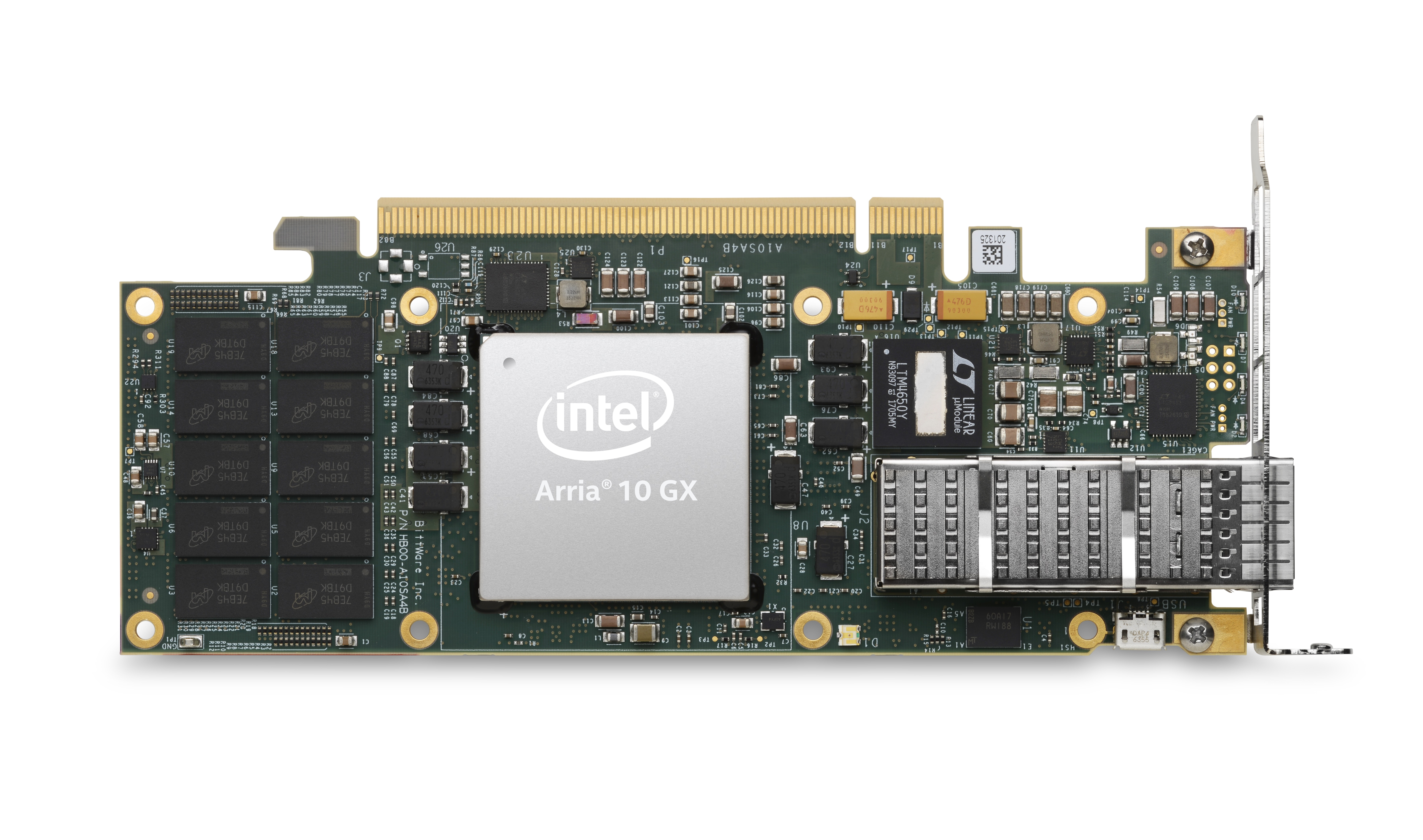 INFRA
INFRA
 INFRA
INFRA
 INFRA
INFRA
Intel Corp. is hoping to entice enterprises to tap into the benefits of its field-programmable gate arrays in order to accelerate their data center workloads.
The chip maker said Wednesday that it’s teaming up with server makers Dell EMC, a subsidiary of Dell Technologies Inc., and Fujitsu Co. Ltd. to put Arria 10 GX Programmable Acceleration Cards (pictured) into their data center hardware.
Dell EMC said it’s making the Arria 10 GX FPGAs available in its PowerEdge R640, R740 and R740XD servers, while Fujitsu will offer early access to the FPGAs through its Primergy RX2540 M4 servers to certain customers.
Intel’s FPGAs are designed to work with its current-generation Xeon computer processing units in order to provide higher levels of performance and efficiency for specific data-intensive workloads. FPGAs are specialized chips that can be programmed and reprogrammed at any time in order to adapt them to specific workloads. They’re just one of several kinds of accelerators being used in tandem with central processing unit chips to boost the performance of data center systems while keeping power consumption in check.
Graphics processing units, such as those built by Nvidia Corp., are another type of accelerator that can perform parallel processing. There are also application-specific integrated circuits, or ASICs, which are integrated circuits that can be customized for different uses. However, Intel said, its FPGAs are superior for many use cases as they can be fully customized for different workloads. FPGAs can also be switched off when not in use, which means they’re more power-efficient, the company said.
“Accelerators, whether they be FPGAs, GPUs or ASICs, all have varying levels of programmability, compute, and power consumption,” said Patrick Moorhead, principal analyst at Moor Insights & Strategy. “Generally speaking, FPGAs enable more hardware and software programmability but are harder to program than GPUs. It all comes down to what exactly you want to accelerate, how much work you want to put into it, how much flexibility you want in programming and, of course, how much investment you want to make.”
Regarding the difficulty of programming FPGAs, Moorhead said Intel is making significant investments behind the scenes to try and fix this. “Intel has very deep pockets,” he said, so it may not be long before some improvements emerge.
The difficulty of programming FPGAs might be one reason why they haven’t seen as much adoption as GPUs or ASICs. Presently, they’re mostly used by scientific research and government institutions, and also big technology firms such as Microsoft Corp., which has rather unique data-heavy requirements and also the expertise to put them to use.
But in this day and age, regular enterprises are also becoming inundated with data, thanks to the rise of cloud computing and the “internet of things.” Enterprises are also trying to grapple with new applications such as artificial intelligence, data analytics and video transcoding. In all of these cases, FPGAs can provide more flexibility, less latency and higher performance, according to Intel, though Nvidia and other GPU makers beg to disagree. In any case, Intel believes enterprises will want to take advantage and make better use of the date they collect.
Intel highlighted two particular workloads that it thinks can benefit from its FPGAs, database acceleration and financial risk analytics.
In the latter case, Intel cited the example of Levyx Inc., which builds processing software for big data infrastructures. The company was an early adopter of Intel’s FPGAs, and used them to create a faster and more efficient financial modeling system for its customers.
“Financial modeling is a big data problem with huge performance sensitivities,” said Matt Meinel, senior vice president of business development for Levyx. “Utilizing the Intel PAC and the Acceleration Stack, our architects and software developers achieved an eight-fold improvement in algorithm execution and twice the speed in options calculation compared to traditional Spark implementations.”
As for database acceleration, Intel said its FPGAs can help boost performance at both the data extraction, transformation and loading and the analytics stages. In turn, that should allow for faster and more complex analysis of real-time data. Intel said its benchmark tests show that the FPGAs speed up real-time data analytics by up to 20 times, with three times greater storage compression.
“We are at the horizon of a new era of data center computing as Dell EMC and Fujitsu put the power and flexibility of Intel FPGAs in mainstream server products,” said Reynette Au, vice president of marketing for Intel’s Programmable Solutions Group. Intel said its FPGAs can also benefit AI, cybersecurity and genomics research.
Support our mission to keep content open and free by engaging with theCUBE community. Join theCUBE’s Alumni Trust Network, where technology leaders connect, share intelligence and create opportunities.
Founded by tech visionaries John Furrier and Dave Vellante, SiliconANGLE Media has built a dynamic ecosystem of industry-leading digital media brands that reach 15+ million elite tech professionals. Our new proprietary theCUBE AI Video Cloud is breaking ground in audience interaction, leveraging theCUBEai.com neural network to help technology companies make data-driven decisions and stay at the forefront of industry conversations.